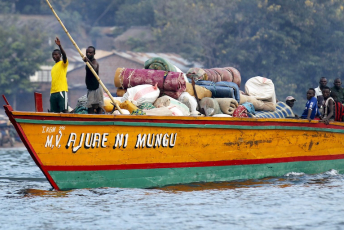The Congo Basin’s rare redwood (Ribuyo) and whitewood (Muvule) are under threat of extinction as Asia’s demand for luxury furniture remains high. Burundian newspaper Ibihe highlights large-scale timber smuggling from the Democratic Republic of the Congo (DRC) into Burundi and then onward to China via East African transit routes, resulting in a serious threat to the DRC’s forest cover.
Redwood and whitewood are illegally harvested from the outskirts of Kahuzi-Biega National Park (PNKB), and from around the villages of Kalonge, Kamakombe, Bisiru, Kabulungu, Bugore and Lwama-Kivu in the protected areas of Ngandja and Itombwe Nature Reserve in the DRC.
Smugglers transport the wood from the Mushimbaki port at Baraka town on Lake Tanganyika, to Kalundu’s port near Uvira. From there, it’s smuggled through Ubwari Island to the port of Rumonge in Burundi, loaded onto trucks, and transported to Bujumbura.
Burundian investigative journalist Arthur Bizimana says traditional leaders give informal permission for timber harvesting on community lands, bypassing legal procedures. Park rangers accept bribes from illegal loggers to fell trees in national parks.
Brokers serve as the middlemen between illegal loggers and buyers in regional and international markets, organising the transportation of the illegally harvested timber. Armed groups tax the illegal trade and protect transporters through conflict zones.
Criminal actors exploit regulatory challenges caused by ongoing conflict in the eastern DRC, which has weakened institutional capacity and fostered systemic corruption, ultimately undermining effective forest governance, Bizimana says. Weak enforcement of forestry laws in the DRC, notably the Forest Code of 2002, exacerbates the illegal cross-border trade.
An Environmental Investigation Agency report highlights the role of Chinese logging companies in promoting illegal logging in the DRC through forged permits. The report names two companies in particular, Wan Peng and Booming Green, as involved in exceeding the legally allowed export quota of 30% of the company’s annual log production, misreporting species to enable overharvesting, and paying bribes.
These activities not only worsen deforestation in the DRC but also expose governance challenges within the country’s forestry sector, where corruption and commercial interests compromise oversight.
The consequences of these enforcement gaps are evident in the scale of illegal timber exports. Despite criminalising raw log exports (except for new concessions that can export up to 30% of harvested wood as logs), between 2015 and 2023, 74% of the DRC’s wood was exported as unprocessed logs, with China as the primary destination.
As of 2024, an estimated almost three million cubic metres of timber left the DRC for Chinese cities, also reflecting inadequate implementation of China’s 2020 Forest Code, which was revised to ban the purchase, processing and transport of illegal logs.
When the illegal timber arrives in Bujumbura, having been transported via the routes described, it is sold by local Indians and Burundians at the city’s Jabe and Asian Quarter markets.
Jabe is known for trading in whitewood, and the Asian Quarter market specialises in redwood, often sold legally at about BIF700 000 (roughly US$235) per plank. Although the sale is legal, the source of the timber and the methods of acquisition are illegal, says Bizimana.
East African countries like Kenya, Uganda and Tanzania also play a crucial role in smuggling these unprocessed logs. Lia is a key border transit point between the DRC and Uganda situated on the route along which protected species such as the African mahogany are brought into Uganda.
Similarly, the Kasindi border post, Watalinga and Bunagana, along with the Kasindi crossing, have been recognised as passage points through which illegally sourced timber from the DRC enters Rwanda.
In an interview with InfoNile, a timber transporter explained that the lack of proper mechanisms to distinguish between legally and illegally acquired timber is exploited by criminal groups involved in the trade. Smugglers bypass enforcement by paying taxes after crossing into Rwanda. This facilitates the movement of illegally sourced timber, often mistakenly identified as legally obtained, into international markets.
The price of a tonne of the highly valued hardwood is estimated to be US$2 500 – $3 000. Although pricing units differ, the sharp increase in value from local markets to international destinations reveals the profit motive that drives smuggling.
Reducing the illegal timber trade calls for increased investment in developing DNA databases for high-value timber in Africa, as noted by ENACT. These databases would help trace the origin of timber even when it has been disguised or processed.
Equally important is the need to uphold the recently signed peace agreement between the DRC and Rwanda. Reducing conflict in the eastern DRC could potentially allow the country to deploy enough security personnel to enforce forestry laws, monitor natural resources more effectively, and hold corrupt officials accountable.
Sanctions on complicit companies and the deployment of specialised border task forces along the DRC-Burundi border to monitor timber trafficking would also be helpful in fighting the illegal timber trade.
Last, regional and international cooperation, especially the active involvement of China as a destination country and East African nations as key transit points, is essential for effectively combatting the illegal timber trade. Targeted consumer awareness campaigns in destination markets such as China could also help highlight the impacts of deforestation, illegal logging and the illicit sale of wood.
Valtino Omolo, Research Officer, ENACT, ISS Nairobi, and Willis Okumu. Senior Researcher, ENACT, ISS Nairobi.
Image: Guerchom Ndebo / AFP







